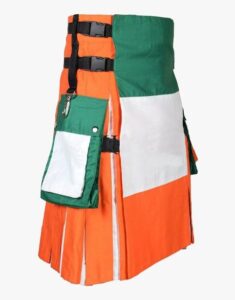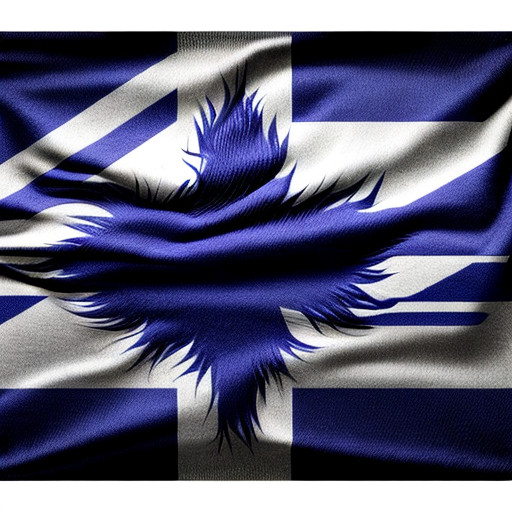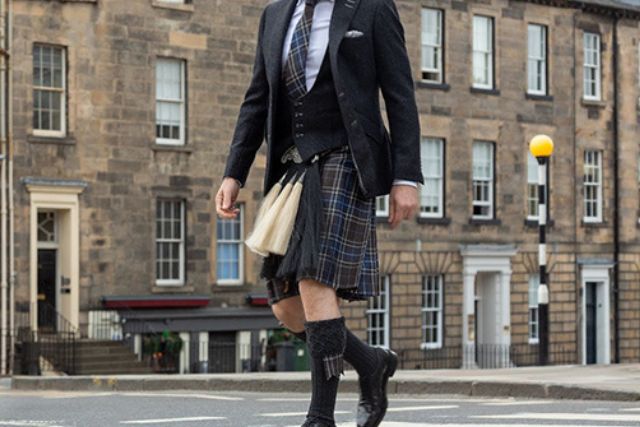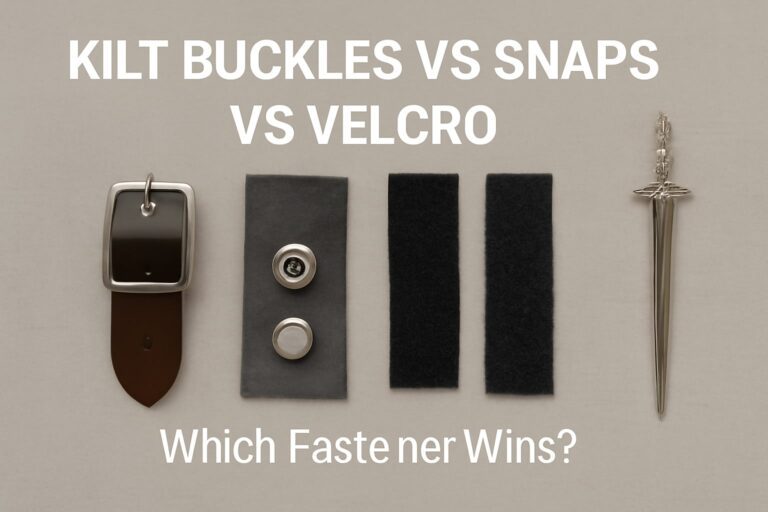Intrinsically woven with the resilient spirit of Ireland, the Irish kilt stands as a vibrant symbol of tradition, heritage, and cultural pride. With its historical origins dating back centuries, this iconic garment has evolved to become a timeless emblem of Irish identity. Discover the essence of Irish tradition and elegance, as we unravel the captivating story of the Irish kilt.
Historical Origins of the Irish Kilt
During the medieval period, the historical origins of the Irish kilt can be traced back to the Gaelic culture and the influence of the Scottish kilt. The Irish kilt, also known as the Irish tartan or Irish plaid, is a traditional garment that has become synonymous with Irish heritage and identity. While the exact origins of the Irish kilt are not well-documented, it is believed to have evolved from the saffron-colored léine, a loose-fitting garment worn by Gaelic warriors.
Over time, the Irish kilt developed its own unique style, incorporating various colors and patterns to represent different clans or regions in Ireland. Today, the Irish kilt is still worn for special occasions and events, with modern Irish kilt outfits combining traditional elements with contemporary designs to showcase Irish pride and culture.

Traditional Materials Used in Irish Kilts
One of the key elements of the Irish kilt is the use of high-quality wool, typically sourced from traditional Irish sheep breeds. This choice of material ensures that Irish kilts are not only durable but also provide comfort and warmth. The traditional materials used in Irish kilts reflect the rich heritage and cultural significance of this garment.
Here are four traditional materials commonly used in Irish kilts:
- Pure Wool: Irish kilts are crafted from pure wool, which is known for its natural insulation properties and ability to retain warmth even in harsh weather conditions.
- Tartan Fabric: Tartan fabric, with its distinctive crisscross pattern, is often used to create the traditional plaid design seen in Irish kilts. Each tartan pattern represents a specific Irish clan or family.
- Linen: Linen, a lightweight and breathable fabric, is sometimes used in the construction of Irish kilts, especially for warmer climates or summer wear.
- Leather: Leather accents, such as belts and sporran pouches, are commonly added to Irish kilts to enhance their aesthetic appeal and functionality.
The Symbolism and Meaning Behind the Irish Kilt
The symbolism and meaning behind the Irish kilt lies in its ability to evoke a sense of ancestral pride and cultural identity within the wearer. The Irish kilt is not just a piece of clothing; it represents a rich heritage and a connection to the past.
The kilt is often made with intricate patterns and colors that hold significance in Irish history and folklore. Each tartan design reflects a specific clan or family, allowing individuals to proudly display their lineage and honor their ancestors. Wearing the Irish kilt is a way to celebrate and preserve Irish traditions, as well as to assert one’s identity and belonging to a vibrant and resilient culture. It is a symbol of freedom, resilience, and the enduring spirit of the Irish people.
Famous Irish Kilts Throughout History
Throughout the annals of history, notable figures such as Irish patriots, renowned musicians, and influential leaders have donned the iconic Irish kilt, cementing its place as a symbol of national pride and cultural heritage. From the battlefields to the stage, the Irish kilt has been worn by individuals who have left an indelible mark on Irish history.
Here are four famous Irish kilts that have stood out throughout history:
- Brian Boru’s Kilt: Brian Boru, the High King of Ireland, wore a kilt adorned with the emblem of the harp, symbolizing his leadership and love for his country.
- Michael Flatley’s Kilt: The legendary Irish dancer, Michael Flatley, captivated audiences worldwide with his energetic performances while wearing a kilt that showcased his Irish roots and passion for traditional music and dance.
- Daniel O’Connell’s Kilt: Daniel O’Connell, a prominent Irish politician and champion of Catholic emancipation, often wore a kilt to symbolize his connection to the people and his fight for freedom and equality.
- Bono’s Kilt: The lead singer of U2, Bono, has been known to don a kilt during live performances, representing his Irish heritage and his dedication to using his platform for social change.
These famous Irish kilts serve as reminders of the resilience, pride, and cultural significance of the Irish people throughout history.
The Evolution of the Irish Kilt Design
A significant aspect of the Irish kilt’s design evolution can be traced back to the incorporation of traditional Celtic patterns and colors that have become synonymous with Irish culture. The evolution of the Irish kilt design can be seen in the development of unique Irish tartans, which are distinct from the Scottish tartans. Irish tartans often feature vibrant colors such as green, blue, and red, reflecting the natural beauty of the Irish landscape.
In addition to the traditional kilt design for men, there has been an emergence of Irish kilts for women, offering a modern twist on the traditional garment. One notable example is the Lein Croich, a style of kilt specifically designed for women, featuring pleats and a sash. The evolution of the Irish kilt design showcases the adaptability and creativity of Irish culture, while maintaining a strong connection to its rich heritage.
How to Properly Wear an Irish Kilt
An essential step in wearing an Irish kilt properly is to ensure that it is worn at the correct length and securely fastened. Here are four important tips to help you properly wear an Irish kilt:
- Length: The kilt should fall to the middle of the knee. Anything shorter or longer may disrupt the traditional look and feel.
- Fastening: Use the kilt’s straps, called ‘kilt pins,’ to secure it around your waist. Make sure it is snug but not too tight, allowing freedom of movement.
- Tartan Alignment: When wearing an Irish tartan kilt, ensure that the vertical and horizontal lines of the pattern align correctly at the front and back.
- Color Coordination: Choose an Irish kilt color that represents your heritage or personal style. Popular options include various shades of green, blue, and red.
Different Styles and Patterns of Irish Kilts
There are various styles and patterns of Irish kilts available, ranging from traditional tartan designs to more modern and unique options. Irish kilts are often associated with tartans, which are woven patterns of colored stripes that represent different clans or families. The most common Irish tartans include the County tartans, which represent the various counties in Ireland, and the Irish National tartan, which is a more generic design representing Irish heritage. In addition to tartans, Irish kilts also come in various solid colors, such as green, blue, and black. Some kilts feature intricate Celtic knotwork or embroidery, adding a touch of Irish symbolism and tradition.
Irish Kilt Accessories: What to Wear With Your Kilt
To complete your Irish kilt ensemble, choose from a variety of accessories such as a sporran and a sgian-dubh. These accessories not only add a touch of style but also serve practical purposes. Here are four essential Irish kilt accessories to consider:
- Sporran: A sporran is a small pouch worn at the front of the kilt. It provides a convenient place to store essentials like keys, wallet, and phone. Sporrans come in various styles, from simple leather designs to more ornate options with Celtic designs.
- Sgian-dubh: The sgian-dubh is a small knife traditionally worn in the sock or boot. While it is primarily decorative nowadays, it has historical significance as a weapon. Choose a sgian-dubh with a handle design that complements your kilt.
- Belt and Buckle: A leather belt and buckle are essential to keep your kilt securely in place. Opt for a belt and buckle that match the color and style of your kilt. Celtic designs are popular choices.
- Kilt Pin: A kilt pin is a decorative pin that is worn on the front apron of the kilt. It adds a touch of flair to your outfit while also preventing the apron from flapping in the wind. Look for a kilt pin that features Irish symbols or motifs.
Irish Kilt Vs. Scottish Kilt
Differentiating between the Irish kilt and the Scottish kilt, the key lies in the distinct patterns and colors that represent each country’s unique cultural heritage. The Irish kilt, also known as the kilted skirt or leine, is traditionally made from solid-colored fabric, often in deep green or saffron yellow, symbolizing Ireland’s lush landscapes and rich history. In contrast, the Scottish kilt features tartan patterns, with different clans having their own specific designs and colors. These tartans are a significant part of Scottish identity and are worn with pride to showcase one’s ancestry.
Additionally, the way the kilts are worn also differs. Irish kilts are usually worn with a belt or sash, while Scottish kilts are typically worn with a sporran, a pouch worn around the waist. Understanding these differences allows for a deeper appreciation of the cultural significance behind each kilt.
The Irish Kilt in Modern Fashion and Pop Culture
A popular trend in modern fashion and pop culture, the Irish kilt has gained significant recognition and admiration for its timeless style and cultural symbolism. With its rich history and traditional significance, the Irish kilt has made its way into the mainstream fashion industry, becoming a symbol of freedom and individuality.
Here are four reasons why the Irish kilt has become a beloved fashion choice:
- Cultural Heritage: The Irish kilt represents a connection to one’s Irish ancestry, allowing wearers to proudly display their heritage through clothing.
- Versatility: Whether it’s a formal event or a casual outing, the Irish kilt can be styled in various ways to suit any occasion.
- Symbolism: The patterns and colors of Irish tartans by surname add depth and meaning to the kilt, reflecting the wearer’s family history and identity.
- Irish Identity: While kilts are often associated with Scotland, the Irish kilt allows individuals to celebrate their unique Irish roots and distinguish themselves from their Scottish counterparts.
In modern pop culture, the Irish kilt has been worn by celebrities and featured in fashion shows, music videos, and movies, further solidifying its place in the fashion world. As a symbol of heritage, versatility, and individuality, the Irish kilt continues to captivate fashion enthusiasts and embrace the spirit of freedom.
Popular Events and Festivals Featuring Irish Kilts
During various cultural celebrations and festive gatherings, Irish kilts are prominently showcased and worn with pride by participants and attendees alike. The Irish kilt has become an iconic symbol of Irish heritage and culture, and it is often featured in popular events and festivals throughout Ireland and the world.
One such event is the St. Patrick’s Day Parade, where thousands of people gather to celebrate Irish culture and showcase their Irish kilts. The Galway Oyster Festival is another popular festival where Irish kilts are worn by participants, adding to the vibrant and colorful atmosphere of the event.
The Irish Kilt as a Wedding Attire
One popular choice for couples looking to incorporate Irish heritage into their wedding is to have the groom and groomsmen wear the Irish kilt. The Irish kilt is a traditional garment that holds great significance in Irish culture and adds a touch of elegance and authenticity to the wedding attire. Incorporating the Irish kilt as wedding attire not only honors Irish traditions but also adds a touch of charm and elegance to the special day.
How to Care for and Maintain Your Irish Kilt
Properly caring for and maintaining your Irish kilt is essential in preserving its quality and ensuring its longevity. Irish kilts, often made from traditional Irish tartan fabric, such as the Irish Lein Croich or the Irish McCarthy Tartan, hold great cultural and historical significance.
- To keep your Irish kilt in pristine condition, it is recommended to follow a few simple steps. Firstly, always store your kilt in a cool, dry place to prevent any moisture damage.
- Secondly, avoid exposing it to direct sunlight for extended periods, as this can cause the fabric to fade. Additionally, regular dry cleaning is recommended to remove any stains or dirt.
- Lastly, be cautious when handling sharp objects or sitting on rough surfaces to prevent any tears or snags.
Irish Kilt Traditions and Customs
Moreover, Irish kilt traditions and customs play a significant role in preserving and honoring the rich cultural heritage of Ireland. These customs have been passed down through generations, and they represent the values and identity of the Irish people. Here are four key customs and traditions associated with the Irish kilt:
- Irish Tartans: The Irish kilt is often designed using specific tartans, which are unique patterns and colors that represent different Irish clans and families. Wearing a specific tartan can signify one’s connection to a particular lineage or region.
- Irish Plaid: The plaid pattern is commonly seen in Irish kilts, and it holds symbolic meaning. The different colors and patterns represent various aspects of Irish culture, such as nature, history, and spirituality.
- Dressing for Special Occasions: The Irish kilt is often worn for special events and celebrations, such as weddings, festivals, and St. Patrick’s Day. It is a way for individuals to showcase their Irish heritage and participate in the cultural festivities.
- Kilt Etiquette: Wearing an Irish kilt comes with certain etiquette rules, such as how to properly wear and care for the garment. These customs ensure that the kilt is respected and maintained for future generations to enjoy.
Where to Buy Authentic Irish Kilts
If you are looking to purchase an authentic Irish kilt, there are several reputable retailers and online platforms where you can find high-quality kilts made with traditional Irish craftsmanship.
One such option is Scottfashion.com, a Custom made Scottish Kilts company that also specializes in Irish kilts. They offer a wide range of kilts made from premium wool and tartan fabrics, ensuring authenticity and durability.
Additionally, you can explore local Irish shops and boutiques, as many of them carry authentic kilts and traditional Irish clothing.
When purchasing an Irish kilt, it is important to ensure that it is made with genuine craftsmanship and materials, so you can truly embrace the rich heritage and culture of Ireland.
Frequently Asked Questions
What Is the Significance of Wearing an Irish Kilt at a Wedding?
Wearing an Irish kilt at a wedding holds cultural significance and symbolizes the wearer’s connection to their Irish heritage. It is a way to honor tradition, showcase cultural pride, and add a touch of uniqueness to the special occasion.
Are There Any Specific Traditions or Customs Associated With Wearing an Irish Kilt?
There are specific traditions and customs associated with wearing an Irish kilt. These include the use of tartan patterns to represent family clans, the wearing of a sporran for practicality, and the inclusion of traditional Celtic symbols in the design.



